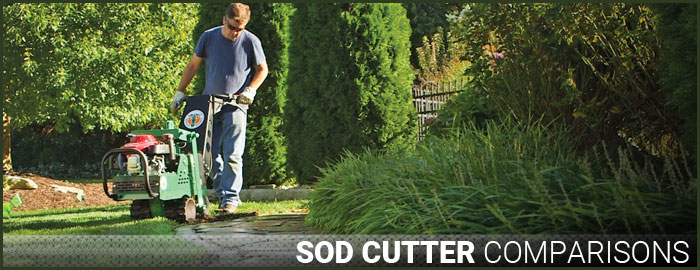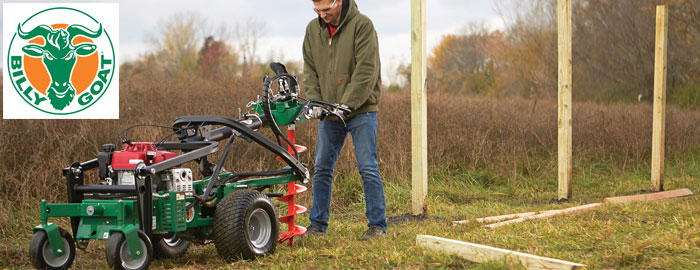The Concept of Common Operator Controls
In the world of outdoor power equipment, the ability to operate machinery with ease and safety is very important. This is where the concept of common operator controls comes into play.

A system of common controls is the standardization of the handles, buttons, switches and other operator controls across different models and types of machinery.
The idea is that once you learn to operate one piece of equipment, you should be able to operate others with little to no extra training.
With Billy Goat equipment, this concept is realized through their common controls design. It’s an approach that not only simplifies equipment operation but also promotes safety and efficiency. Many models of Billy Goat lawn and leaf vacuums, over-seeders, aerators, post-hole diggers, and brushcutters feature Billy Goat common controls.
Landscaping professionals do many types of work and frequently need to switch from operating one type of machine to another. The beauty of common controls is that they eliminate the need for operators to constantly adjust to different control systems when switching from one task to another. This improves productivity by simplifying the operation process and reducing the risk of errors.
A Detailed Look at the Billy Goat Controls Design
The core part of Billy Goat Common Controls is a system for operating Billy Goat machines with hydrostatic drive. Hydrostatic drive systems use a combination of hydraulic pumps and wheel motors to provide drive power to the wheels.
Billy Goat controls allow the operator to precisely feather the forward and reverse drive speeds of the equipment. No shifting is required, eliminating the possibility of irregular operation and jerks.
One key aspect of the Billy Goat controls is their ergonomic design. The controls are positioned in such a way that they’re within easy reach and easy to operate. There are no pushing movements required. This results in less fatigue for the operator and increased efficiency.
Another feature is the use of universal symbols on the control knobs and levers. This makes it easy to understand what each control does, regardless of the type of Billy Goat equipment you’re operating. The aim is to reduce the learning curve and make it easier for operators to switch between different types of equipment.
Whether you’re operating a Billy Goat brushcutter or an aerator, you’ll find the controls in the same place, functioning in the same way.
The Important Role of Common Control Features in Operator Safety
Safety is a major consideration in the design of Billy Goat equipment. The common control features play an important role in ensuring operator safety. By standardizing the controls across different equipment, Billy Goat reduces the likelihood of operator errors that could lead to accidents.
The operator doesn’t have to use trial and error to figure out the controls when switching from one machine to another. This consistency helps to prevent accidents and promotes a safer work environment.
How Billy Goat Common Controls Reduce the Operator Learning Curve
In addition to promoting safety, the common controls on Billy Goat equipment also reduce the operator learning curve. This means that operators don’t need to spend excess time figuring out how to work each piece of machinery. The standardized controls across different Billy Goat models make transitioning from one machine to another seamless.
The common control features allow operators to apply the skills and knowledge they’ve gained from operating one piece of Billy Goat machinery to others. This is a significant advantage, especially in environments where a crew of operators is running a fleet of equipment, and frequently switching around between different equipment.
The reduced learning curve not only saves time but also boosts productivity. With less time spent on training new employees to operate equipment, both supervisors and operators can focus more on the task at hand. This leads to increased efficiency and better results.
Billy Goat Models That Feature Common Controls
Not all Billy Goat models feature common controls. However, most models that have hydro-drive transmissions do have these controls.
These models include the AE1300H aerator, OS901SPH overseeder, AGR1301H landscape auger, PL2501SP plugger aerator models, SC181 and SC240HG sod cutter models, and the BC2601 brushcutter models. Future models are likely to include the same common controls.
Getting Replacement Parts for Billy Goat Controls
Maintaining your Billy Goat equipment in top shape is essential for its optimal performance. This includes regularly checking and replacing the control parts when necessary. The good news is, getting replacement parts for Billy Goat controls is straightforward and convenient.
You can buy parts for Billy Goat equipment from parts.shankslawn.com. The site has exhaustive catalogs of exploded-view parts diagrams to ensure you can find exactly what you need for your equipment maintenance. As all parts are original Billy Goat parts, you can be confident that the parts you get will fit perfectly into your Billy Goat machinery.
In conclusion, the common controls on Billy Goat equipment provide a safe, simple, and standardized operation. They reduce the operator learning curve, improve safety, and increase efficiency. Whether you’re a professional landscaper or a homeowner, Billy Goat equipment with common controls are an excellent choice for many types of outdoor tasks.


